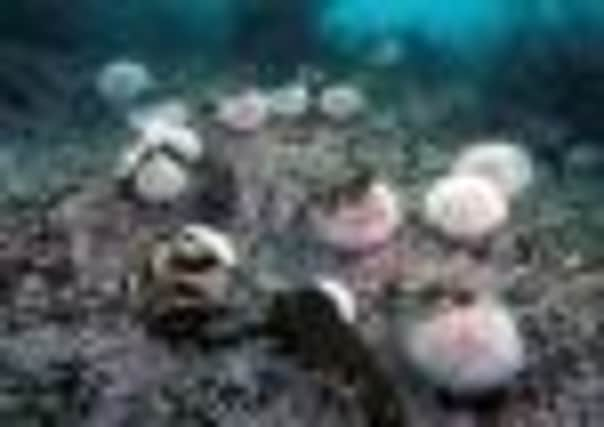Spiky, regenerating sea urchin could hold cure for cancers


THEY may look a cross between a squash ball and a hedgehog, but experts believe sea urchins could hold the key to new treatments for a range of illnesses.
The spiky creatures are believed to contain the genetic key to curing Alzheimer’s, heart disease and some cancers.
Advertisement
Hide AdAdvertisement
Hide AdScientists at St Andrews University found the purple variety of sea urchins have a special genetic sequence previously only thought to be used by viruses.
They will now use the creatures to try and produce a therapeutic response to human cells, potentially leading to breakthrough treatments for some of the most chronic conditions.
This latest finding builds on a previous discovery of a short genetic sequence, known as 2A, caused by viruses, which can be used to return cells to a stem cell-like state.
Stem cells are cells with the potential to develop into many different types of cells and serve as a repair system for the body.
Experts hope to use the cells from sea urchins to look for, and test, new treatments.
Lead researcher Martin Ryan, professor of translational virology at the university, said: “It is now possible to take cells from a patient and drive them back into a stem cell state. This is a massive step forward.
“These patient-specific stem cells could be used to treat a wide range of diseases such as cancer, Parkinson’s, Alzheimer’s, and heart disease.”
Originally, the research team thought the 2A sequence was part of a trick played on the host cell by viruses that infected the body. Discovering the same sequence in creatures such as sea urchins shows the sequence is created by cells themselves, and experts now believe they could be found in many different types of animal.
Advertisement
Hide AdAdvertisement
Hide AdProf Ryan said: “Studying these sequences in creatures such as the sea urchin will provide more tools in the fight against disease and for use in biotechnology.”
“This sequence was first discovered in foot-and-mouth disease virus, but we now know it is found in many other types of virus.
“The sequence has been used in human gene therapy clinical trials to treat a number of cancers including melanoma.
“It has also been used to produce human stem cells, a very important step in regenerative medicine”.
Sea urchins are marine animals found all over the world in all oceans, warm or cold water, and live in a variety of environments in many different parts of the world.
They are often found in rock pools and mud, on wave-exposed rocks, on coral reefs in kelp forests and in sea-grass beds.
Like starfish, sea urchins have a certain regenerative ability, so if its spine is damaged a sea urchin can re-build itself.
Sea urchins’ roe – the edible portion inside the shell – is a substitute for caviar in high-class restaurants, with a 100g serving selling for at least £10.
Advertisement
Hide AdAdvertisement
Hide AdIn the deep-sea lochs of north-west Sutherland, fish farmers and scientists have already discovered new breeding techniques to cultivate the common spiky green urchin in sufficient sustainable quantities.
Urchins have been considered a delicacy since Roman times and until about 100 years ago they were a common food source for coastal communities around Britain